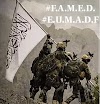The coup plan, titled the Balyoz [Sledgehammer] Security Operation Plan, was drafted in 2003, shortly after the Justice and Development Party (AK Party) came to power. The masterminds of the plan were retired Gen. Çetin Doğan, the then- commander of the 1st Army, retired Former Air Forces Commander Gen. İbrahim Fırtına and retired Gen. Ergin Saygun.
The Taraf report claimed that the coup plan -- a nearly 5,000-page document -- was agreed at a military meeting attended by 162 active TSK members, including 29 generals. According to the plan, the military was to systematically foment chaos in society through violent acts, among which were planned bomb attacks on the Fatih and Beyazıt mosques in İstanbul. The two are among the most frequented mosques in the city.
The bomb attacks were code-named “Çarşaf” (Black Chador) and “Sakal” (Beard) and were to be launched on a Friday, shortly after prayers. A nine-member squad -- under the command of a captain identified only by his initials, H.T. -- was to plant a remote-controlled bomb in a shoe cabinet at Fatih Mosque before leaving the building. The bomb would be detonated only seconds after the completion of the Friday prayer. A number of provocateurs would help increase chaotic atmosphere inside the mosque. At Beyazıt Mosque, a similar bomb would be placed in the garden of the mosque by a team of gendarmerie officers, led by Maj. H.Ö. The bomb would be detonated around 10 minutes before the call to Friday prayer. Provocateurs were to take to the scene once again, this time urging the frustrated crowd to hold violent rallies across the city. The desired result of these rallies would be an increase in domestic pressure on the AK Party government over their failure to ensure the security of people attending prayers at mosques.
The names of former Naval Forces Commander Adm. Özden Örnek -- the author of controversial diaries which revealed that four force commanders devised plans in 2004 to stage two military coups -- retired Brig. Gen. Süha Tanyeri and retired Col. Fikri Karadağ are also frequently mentioned in the plan. Retired military judge Ümit Kardaş told Today’s Zaman that he was not surprised by the coup plan at all. “There has always been a junta within the military. Nothing surprises me. There has been no investigation into the generals [whose names are cited in the plan]. It is not certain how the judiciary will act on the coup plan. Why hasn’t there been a parliamentary commission to investigate coup plans? The government is like a lame duck. It has been declared the focal point of anti-secular activities. A certain group in the media has been obsessed with claims of civilian fascism. The public is totally confused. … How will we call the security forces to account? No one is discussing this point,” he added. TSK would crash its own jetThe Thunderstorm Air Operation Plan, part of the coup plan, was dedicated to a number of TSK plots to create tensions between Turkish and Greek military aircraft, which would culminate in a Turkish jet crashing after a skirmish with Greek jets. The TSK would get the jet to crash if the plan failed. According to the plan, Turkish military aircraft would provoke Greek pilots by entering Greek airspace. A dogfight between aircraft of the two countries would result in the crash of a Turkish jet. If they were unable to provoke Greece, a Turkish pilot would crash one of the Turkish jets, blaming it on the Greeks. Subsequently, the Turkish media would accuse the AK Party government of failing to ensure the security of the country. The tension would increase in the following days, with Turkish security forces patrolling Turkey’s borders with Greece. The Turkish navy would increase the number of training exercises in the Aegean Sea, giving the impression that they were preparing to go to war with Greece. Warplanes would be kept ready for flight at the Balıkesir, Bandırma, Çiğli, Çorlu and Dalaman airports. A group of high-ranking members of the military would increase their dialogue with businessmen, jurists and the public in order to boost the image of the Turkish military in the eyes of the public.
The plan clearly stated the desired result of the tension between Turkey and Greece: “By using the existing weapons systems, psychological pressure will be inflicted on the government and Parliament.” The Sept. 12, 1980 coup d’état, the most violent military intervention in Turkish history, was an example for the Sledgehammer Security Operation Plan. The plan states that the Sept. 12 coup put an end to all the problems and chaos in the country. “There is no need for extra efforts for the elimination of a similar threat. The easiest method would be the implementation of a Sept. 12-like operation,” noted the plan. Plot to attack the İstanbul Aviation MuseumThe coup plan also aimed to ignite tension between members of the military and “fundamentalist groups” in society in the name of the protection of the country’s secular values. According to the plan, the members of the 34th Fleet Command would hold a rally in Kadıköy Square. A huge number of people would attend the rally. A second rally would be held in the conservative Çarşamba area of the Fatih district. The rally would be followed by an attack on the İstanbul Aviation Museum in Yeşilköy by men and women in tunics and black chadors. The attackers would throw Molotov cocktails at the museum and would carry green flags representing Islam. The planned attack was to show conservative Muslims as enemies of the secular republic and worsen relations between the TSK and the AK Party government. The museum attack would be followed by a series of similar attacks at military facilities, including the 3rd and 8th Main Jet Base Commands. The force behind the attacks would again be fundamentalist groups that want to bring Shariah to Turkey. After the attacks, security forces would start patrolling streets and roads as if it was a period of military rule. The security forces would detain suspected individuals and would use weapons if necessary. “Activities will continue without interruption until the government declares martial law. If Parliament fails to garner the required support of deputies for the declaration of martial law, the Air Forces Command will stage air shows in Ankara’s city center upon an invitation by the Ankara Chamber of Commerce [ATO]. The low-altitude flights above the Parliament building will make deputies feel the presence of the TSK,” stated the coup plan. ‘AK Party, major threat to secular order’The coup plan also described the “enemies” and “friends” of the armed forces in the country. According to the document, the AK Party stands as the major threat to Turkey’s secular order. “Encouraged by the practices of the ruling party, reactionary groups interpret the principle of secularism, which stands as the basis of our state structure, in accordance with their own interests and objectives. Within this scope, it is widely seen that they insist on using the headscarf -- a symbol of the movement of reactionaryism -- in many state institutions. Such an insistence is aimed at establishing a state order based on religion, which is against the principles of a secular republic,” suggested the document. The plan accuses the AK Party of serving the interests of the United States and the European Union instead of the interests of the Turkish Republic and allowing reactionaryism to gain ground in the country. “The followers of the AK Party and religious communities are rapidly setting up their own cadres in state posts. Using the opportunity of being the ruling party, the AK Party is working to make the media, civil society organizations and the bureaucracy dependent on the government. The party also aims to restore an [religious] education system through tekke and zaviyes [dervish lodges] to train fundamentalist individuals,” reads the document. The plan also criticized the EU and Middle Eastern countries for lending support to the reactionary and separatist activities of the AK Party. The plan stated that the AK Party received around 30 percent of the vote in the Nov. 3, 2002 parliamentary elections, but a significant percentage of the vote for the party came from voters who were protesting the lack of a strong political will in the country. The plan expressed the military’s displeasure at the AK Party being represented in Parliament. “It has become an urgent need to remove them [the followers of the AK Party] not only from the TSK but also from all public institutions. Our plans and activities to protect the republic are ongoing,” notes the plan. The plan also called for more coordinated activities with the Support for Modern Life Association (ÇYDD), the Atatürkist Thought Association (ADD) and the Turkey Youth Union (TGB). “We will continue coordinating our activities and attitudes with the opposition parties to thwart any propaganda or legal amendment by the AK Party [against the secular order of the country],” adds the coup plan. | ||
http://www.todayszaman.com/tz-web/news-199198-yet-another-subversive-plot-against-ak-party-exposed.html






0 Comments